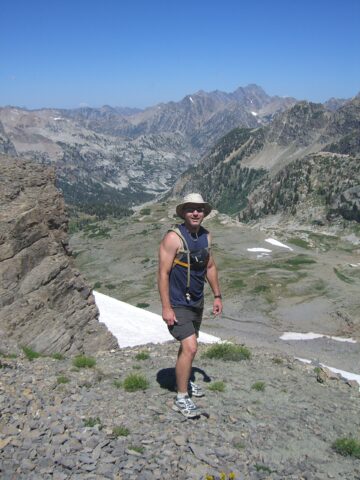Grand Teton National Park is, simply put, a hiker’s paradise. It’s got stirring scenery, epic inclines, and beautiful skies. It’s got routes for every age and skill level to enjoy. But in order to continue enjoying those hikes, of course, you have to stay alive and healthy. That’s sort of an essential prerequisite, actually. So to aid you in this endeavor, here’s a list of essential hiking safety tips for Grand Teton National Park (and hiking anywhere else, really). [caption id="attachment_2633" align="alignright" width="360"]

We don't know who this guy is. (The picture is public domain.) But let's hope he's practicing proper hiking safety.[/caption]
Gear Up and Get Out
There’s an uncanny allure to buying new outdoor gear, for sure—but you don’t have to clean out REI in order to fully enjoy the outdoors. Grab these essentials before heading out on your next hiking trip. You might notice a few omissions from our list, but that’s likely because we’ll cover a few other things in more depth below. (If you’re looking for a more in-depth list, look here.) - First aid kit
- Boots with good ankle support
- Knife or multi-tool
- Sunscreen
- Whistle
- Bear repellent
- Fire starter
- Bug spray
- Trekking poles (if you need them)
- Satellite phone (if you’re going off the grid for a while)
- Flashlight
- Toilet paper
Eat, Drink, and Be Healthy
This goes without saying, but make sure to bring water. Once I went on a long hike with my brother. I forgot my water; my brother didn’t. Rather than share, he made me drink questionably colored snow to make sure I learned my lesson. So make sure to bring lots of water or your brother might be a jerk about it. Sports drinks are also great, but leave the chardonnay and Mountain Dew at home; soda or alcohol will dehydrate you. If you plan to grab your water on the trail, make sure you have a way to purify it. Take your pick: water filters work quickly but tend to break down, while tablets take a while to work but are a lot cheaper. As far as food goes, you want snacks that will help you replace lost calories and keep your blood sugar up. Try items like jerky, fruit (dehydrated fruit is great), peanut butter (very high in protein), bagels, various kinds of granola bars, and trail mix. Don’t eat anything too heavy. Prepare for the Worst
Being prepared isn’t just for Boy Scouts and regicidal lions. You’ll want to bring extra layers in case the weather gets nasty, including something rainproof. Make sure you bring a map of some sort. GPS units and apps are great and all, but paper maps never run out of batteries or disappear because they lost service. Familiarize yourself with the area you’re visiting, and have a plan in case you don’t make it out at your desired pace and have to walk in the dark.Use Common Sense
Just don’t do anything stupid. If you see a wild animal, don’t approach it unless you want to have a brutal close encounter of the herd kind. And speaking of herds, it’s best not to hike alone. If you insist on communing with nature in blissful isolation, at least tell someone exactly where you’re going ahead of time. Tell them when you expect to get back, too. Do you feel safer already? What hiking safety tips did we miss? Let us know in the comments. This post was brought to you by Flat Creek Inn, Jackson Hole’s closest lodgings to all those great Grand Teton hiking trails. *** Ryan Kunz is a copywriter and freelance writer who writes on a variety of topics, including media, the outdoors, and whatever else strikes his fancy. He enjoys hiking and now always remembers to bring water. 
 We don't know who this guy is. (The picture is public domain.) But let's hope he's practicing proper hiking safety.[/caption]
We don't know who this guy is. (The picture is public domain.) But let's hope he's practicing proper hiking safety.[/caption] We don't know who this guy is. (The picture is public domain.) But let's hope he's practicing proper hiking safety.[/caption]
We don't know who this guy is. (The picture is public domain.) But let's hope he's practicing proper hiking safety.[/caption]
